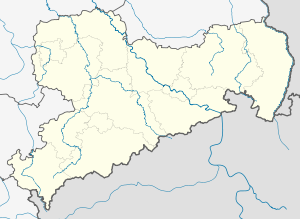Hoyerswerda Zoo
| Hoyerswerda Zoo | ||
|---|---|---|
| Full name | Zoo Hoyerswerda / Zwěrjenc Wojerecy | |
| place | Am Haag 20, 02977 Hoyerswerda |
|
| surface | 6 hectares | |
| opening | 1956 | |
| Animal species | 120 (2013) | |
| Individuals | 1044 animals (2013) | |
| Visitor numbers | nearly 150,000 | |
| organization | ||
| management | Eugène Bruins | |
| Sponsorship | Zoo, culture and education Hoyerswerda gGmbH | |
| Funding organizations | Association of Zoofreunde Hoyerswerda eV | |
| Member of | EAZA , VDZ , DTG , DWV | |
|
View from Hoyerswerda Castle over the area |
||
| www.kulturzoo-hy.de | ||
|
|
||
Coordinates: 51 ° 26 ′ 17.5 ″ N , 14 ° 14 ′ 55 ″ E
The Hoyerswerda Zoo , in Upper Sorbian Zwěrjenc Wojerecy (Hoyerswerda Zoo), is a zoological garden in Hoyerswerda . On an area of six hectares there are approx. 1044 animals in 120 forms and 120 plants in 56 species. The zoo has around 150,000 visitors annually and is located in the center of the old town, right by the castle .
history
The establishment began with the initiative of a nature lover who settled some exotic ducks and swans at the castle moat in the early 1950s. Enthusiastic about this idea, Günter Peters, the then director of the museum located in the castle, built the first animal enclosures with helpers from the National Reconstruction Agency .
In addition to the fauna, the tree population in Hoyerswerda is also noteworthy, including the ginkgo tree, primeval sequoia , hackberry and katsura tree . An ornithological and geological nature trail is also offered.
The Hoyerswerda Zoo has emerged from the former zoo since 1994. One of the biggest attractions is the new tropical house opened in 1997. But the bird of prey station , which looks after injured birds of prey in Europe and releases them back into nature, is also attracting international attention. In Hoyerswerda, the world's first breeding of the four-color tangerines and the Tonkibülbüls , two exotic species of birds. Hoyerswerda is internationally recognized as an otter breeding and research facility.
Visitor magnets today are the brown bears, the Galápagos giant tortoises , the diamond crocodiles , red-crowned cranes , hornbills, otters , Humboldt penguins , meerkats , Amur tigers , servals , desert lynxes , sable antelopes and plains zebras . The last of the Hindu Leopards was euthanized in March 2014 at an old age. The enclosure is currently being revised, as keeping and breeding is still planned.
From 1975 to 1989 nine international sculpture symposia were held in the zoo under the direction of Jürgen von Woyski .
Free running marmosets in the tropical house
Monuments
There are also 26 cultural monuments on the zoo grounds. These include the sculptures "Hippopotamus", "Children's dance", "Dancer", "Tree", "Collar bear", "Group of goats", "Girl with dog", "Plant tower with peacocks", "Billy goat", "Lovers under the umbrella ”,“ Penguins ”,“ Writing boy ”,“ Cranes ”,“ Günther Peters ”,“ Owl ”,“ Children with turtle ”,“ Rea ”,“ Vietnamese girl ”,“ Hippos and buffalo ”, the mural“ Rural Festival ", The screen" Birds ", the fountains" Sorbian Easter Fountain "and" Crown Fountain ", a planter with ship motifs, the ceramic panels" Air - Earth - Water "and the relief" From I to We "( LPG discussion).
Movie
In 1989, the seven-part television series Tierparkgeschichten was recorded in the Hoyerswerda zoo, the Stralsund zoo and the Eberswalde zoo . The series was first broadcast on GDR television on June 2, 1989.
Web links
Individual evidence
- ↑ Zoo history. Retrieved on July 26, 2020 (German).
- ↑ The last leopard in Hoyerswerda Zoo is dead. Press release of the Lausitzer Rundschau from March 19, 2014.









